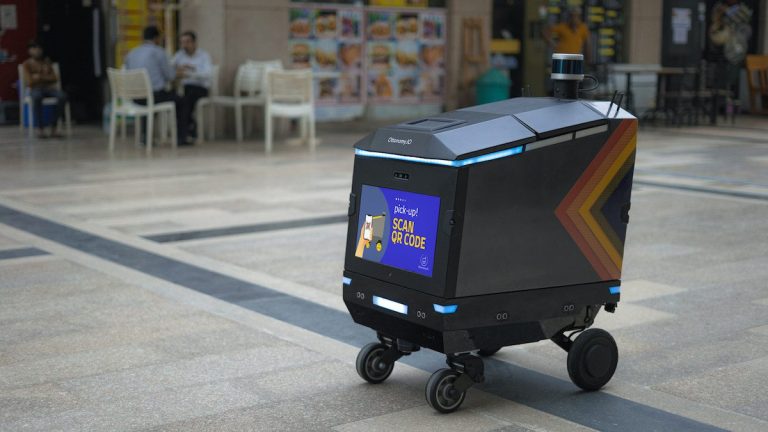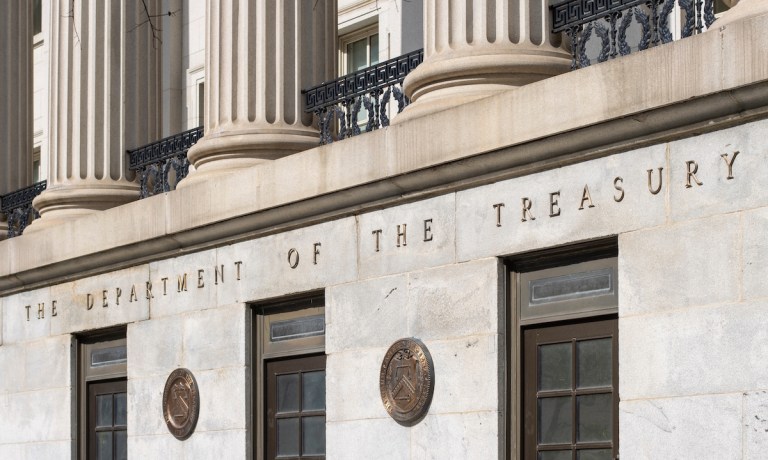Restaurants Turn to Robotics to Fulfill Delivery Demand

As restaurants struggle to meet consumers’ desire for on-demand delivery in the face of labor challenges, robotic solutions are gaining traction.
Technology startup Ottonomy.IO announced Tuesday (April 26) plans to expand the use of its autonomous delivery robots internationally, with the company beginning pilot tests in airports in Rome and Pittsburgh and with plans to roll out additional trials in North America, Europe and the Middle East throughout the rest of the year.
“Ottobots have been in pilots with retailers and restaurants across North America. Our multiple trials have highlighted that the robots can safely navigate in crowded and populated indoor environments and outdoors on varying terrains and weather conditions,” Ottonomy.io CEO and Co-Founder Ritukar Vijay said in a statement.
Additionally, earlier this month, it was reported that Brinker International, parent company of Chili’s Grill and Bar and Maggiano’s Little Italy in addition to two virtual brands, is trying out autonomous delivery via Serve Robotics’ sidewalk delivery rovers. The news came after, at the end of March, the company announced the expansion of its drone delivery test to Texas.
Read more: Chili’s Parent Trials Sidewalk Delivery Robots
In an interview earlier this month with PYMNTS, Brinker International Senior Vice President and Head of Innovation Wade Allen said drone delivery can help meet consumers’ rising demand for digital convenience.
“Delivery is really inefficient,” Allen said. “It’s a half-ton vehicle. It’s a single person generally taking food somewhere between a mile to two miles. Gas prices are going up. There’s pressure on labor or there’s just a lot of expense in that. It’s really inefficient. So, you start to think about, ‘Hey, is there a smarter way to do this?’ And drones are one way in particular that … could solve a problem … and take a lot of cost out of that structure.”
See more: Chili Parent Brinker International Says Automation Is the ‘Heartbeat’ of Innovation
A sizable share of consumers order delivery on a regular basis. Research from PYMNTS’ March/April study “The Digital Divide: Regional Variations in U.S. Food Ordering Trends and Digital Adoption,” created in collaboration with Paytronix, found that about one in three had ordered from a restaurant aggregator such as DoorDash or Uber Eats in the previous 30 days.
Read more: New Research Shows That Regional Dining Quirks Matter in Tailoring Restaurant Offers
Moreover, restaurants that can meet consumers’ demand for delivery outperform their non-delivering counterparts. Research from PYMNTS’ 2022 Restaurant Friction Index, also created in collaboration with Paytronix, found that 97% of top- and middle-performing restaurants offer delivery, while only two-thirds of bottom performers do the same.
See more: Loyalty Programs Best Way to Get Diners to Spend More
Last month, robotics company Starship announced the launch of its autonomous food delivery service at The University of Tennessee, Knoxville, and ghost kitchen company Reef Technology announced a partnership with robotics startup Cartken to launch robotic delivery in Miami.
“Delivery continues to be the driving force behind supporting many of our beloved restaurants while staying safe during this pandemic. However, the rising demand for delivery has created a bottleneck during peak dining hours that slows efficiency,” said Reef Chief Technology Officer Matt Lindenberger in a statement. “We’re looking at our robot delivery service as a long-term solution that can advance the delivery ecosystem by offering speed, quality and scale while reducing congestion and carbon emission.”
Treasury Secretary: DOGE Has Found $50 Billion in Savings

The U.S. Treasury Secretary says a new government cost-cutting effort has found $50 billion in savings.
Speaking to Fox News Tuesday (Feb. 18) evening, Scott Bessent said the work by the “Department of Government Efficiency” (DOGE), a group created by executive order last month, could ultimately lead to “several percent of GDP that we are saving.”
The secretary added that the public doesn’t “have to be concerned about any of this,” in reference to attempts by the Elon Musk-connected team to access taxpayer data, leading Democratic lawmakers to raise concerns about privacy.
At the Internal Revenue Service, Bessent said, there’s one member of the DOGE team “looking at an outdated IT system, that’s all they’re doing.”
Bessent said two people at Treasury had “read only access” to the payments systems, meaning they don’t have the ability to make any changes. “There are very strict guardrails around them,” he said.
The $50 billion figure is slightly lower than the $55 billion in savings DOGE claims to have found so far. However, a report from Bloomberg News Wednesday (Feb. 19) notes that while DOGE says it has saved $55 billion, its website accounts for just $16.6 billion.
That site also includes an error, the report added, mislabeling an $8 million contract as $8 billion, reducing the amount of the group’s itemized savings by nearly half.
DOGE’s efforts have helped bring about hundreds of thousands of government layoffs, some of which have been rescinded as departments realized they were missing crucial workers.
For example, the mass firings led to the dismissal of a team in the U.S. Department of Agriculture working on the government’s response to the avian flu. The department has said it is now trying to reverse the firings.
In another incident last week, the National Nuclear Security Administration rescinded firings for employees responsible for monitoring the nation’s nuclear stockpile, only to discover it had no way of getting in touch with said employees.
The idea for DOGE was first floated last year, with President Donald Trump announcing that Musk would lead the project. However, the administration has since said that Musk was an advisor to the White House, and not in charge of the department.
In a recent interview with PYMNTS CEO Karen Webster, Amias Gerety, a Treasury official for the Obama administration, warned of the consequences if DOGE’s efforts to access payment systems created uncertainty.
“If there’s one phrase that dominates discussions about the Treasury’s role in the nation’s finances, it’s ‘full faith and credit,’” Gerety said.
“The full faith and credit of the U.S. government should not be impeached. It’s literally in the [Constitution]. If you’re a bank, if you’re an investor, if you’re a government contractor, if you’re a retiree receiving Social Security — you have to ask, will my payments go through? That uncertainty should be felt around the world.”